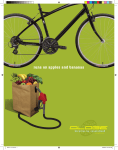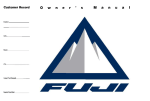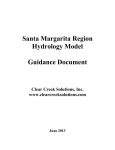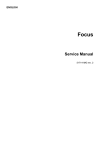Download Fuji Bikes Carbon Team (Int'l) User's Manual
Transcript
Dear Fuji Customer: Congratulations! The carbon fiber Fuji bike that you have chosen is among the finest of advanced products available in cycling. And while Fuji’s frames and forks pass the very highest of safety standards during production, carbon fiber remains a unique material that requires care and maintenance once you’ve taken your bike home. Please take a moment to review these carbon fiber care instructions so that you can get the most out of your ride. Also, please note that Fuji is proud to offer a Limited Lifetime Warranty on all of our bicycles. For more information, contact your local authorized Fuji dealer. You can find a list as well as other valuable information about Fuji’s products at www.fujibikes.com. Sincerely, Patrick J. Cunnane President, Advanced Sports, Inc. / Fuji Bicycles CARBON FORK INSTALLATION GUIDE Please read the following instructions regarding carbon fork installation. If you have any doubt about your mechanical ability, please visit your local authorized Fuji dealer. Fuji recommends that the fork be installed according to recommended torque specifications. Also, please heed the following warnings. Failure to follow any warnings may result in a catastrophic failure of the fork which may, in turn, result in serious injury or death. Warning: The recommended torque specs in the guide are specific for this Fuji product. Refer to owners manual for the mating component’s recommended torque. Always use the lower torque recommendation. 1. COMPONENT PREPARATION Make sure that there are no burrs or sharp edges that could damage the surface in contact with each other. If burrs or sharp edges exist, use a fine grit sandpaper to eliminate. Make sure that all edges that are in contact with the steerer are rounded out to eliminate any stress points. Warning: Burrs or sharp edges can damage the steerer tube. Any deep scratch or gouge in the fork can weaken the component resulting in failure, causing serious injury or death. NOTE: Do not use internal wedge clamp style stems which can cause damage to the steerer tube when tightened. Fuji recommends using an external slotted clamp. (See fig. 1) 2. FORK PREPARATION Lightly grease the base of the steerer tube before installing the crown race. Seat the crown race onto the base of the steerer tube using a crown race installation tool. While installing the crown race, the fork should be held by the legs. Placing the fork dropouts on any surface can damage the dropouts. Insert the headset into the frame following the headset manufacturer’s instructions. Insert the steerer tube into the frame. Place the desired amount of headset spacers and the stem. DO NOT APPLY ANY GREASE TO THE STEERER TUBE. NOTE: Installing more than 40mm (1.5”) stack height of headset spacers can compromise the strength of the steerer tube. It is recommended that the initial installation of the fork be done with the maximum allowed stack height (40mm) of headset spacers, unless the desired stem height is pre-determined. Place the spacers above or below the stem to adjust your position. Once a precise stem height is achieved, a cut can be made to eliminate any spacers that are above the stem. 3. CUTTING THE FORK STEERER TUBE Make a mark on the steerer tube at the top of the stem once the desired stem height is achieved. The actual cutting line must be 2mm below the mark. Before cutting the steerer tube, wrap the area where you intend to cut with several layers of masking tape or duct tape. This will limit the amount of fraying of fibers, resulting in a cleaner cut. Once wrapped, determine the exact location of the desired cut by a pen mark on the tape. NOTE: It is recommended that a fine tooth (36 teeth) saw blade be used to avoid the fraying of composite fibers. A carbide grit toothless saw blade is also acceptable. Please abide by the adage: “check twice, cut once!” It’s much easier than buying a new fork. NOTE: Fuji recommends that when cutting a steerer tube, a steerer tube cutting guide tool be used. It is very important that the steerer tube be cut straight. Once the steerer tube is cut, round out the top edge of the steerer tube by using an emery board or fine grit sandpaper. Wipe off excess dust. DO NOT breathe carbon dust! 4. FORK INSTALLATION Install the steerer tube plug. Insert the fork back into the headset and place the desired amount of headset spacers to achieve proper stem height. When proper height is achieved, install the preload cap. NOTE: Do not twist stem onto carbon steerer tube. This could result in damage to the steerer tube and render the fork unsafe. Adjust the headset to eliminate any free play, make sure that the fork still rotates freely. Make sure that the stem and fork are aligned. Tighten the stem’s top and bottom steerer clamp bolts in an alternating pattern. Increase torque in 5 in-lbf (0.56 Nm) increments, until the specified torque is achieved. Recommended torque for the steerer tube is 75 in-lbf (8.5 Nm). Do not exceed maximum torque of 90 in-lbf (10.1 Nm). Install the front brake on the fork. Recommended torque is 70 in-lbf (8 Nm). Do not exceed maximum torque of 87 in-lbf (10 Nm). Warning: It may be visually difficult to identify damage to the composite material. If the external composite surface is dented, frayed, gouged, deeply scratched, fractured, chipped or otherwise damaged, the component should be replaced. If seat post has been involved in a crash or impact, even if there is no visible damage, Fuji or an authorized Fuji dealer should inspect the product. CARBON SEAT POST INSTALLATION GUIDE Please read the following instructions. If you have any doubt regarding your mechanical ability, visit your local authorized Fuji dealer. Fuji recommends that the seat post be installed according to recommended torque specification. Please read the following warnings. Failure to follow any warning may result in a catastrophic failure of the seat post, resulting in serious injury or death. This phrase may not be repeated in connection with each warning. Warning: This product is designed for road use only. This seat post is NOT intended for off-road use. Warning: Recommended torques in this guide are specific for Fuji seat posts. Refer to the owners manual for the mating component’s recommended torque. Use the lowers torque recommendation. 1. SURFACE PREPARATION Before installing the seat post, follow the steps below: a. Remove all burrs and square edges from seat tube surfaces in contact with the seat post. These edges and burrs can dig into the material, compromising the strength of the carbon. Warning: Any deep scratch or gouge in the seat post can weaken the seat post resulting in failure, causing serious personal injury or death. b. Round posts: when using a standard seat clamp mechanism, the seat post collar should be positioned 180 degrees opposite the seat tube slot. This reduces the possibility of the edges of the seat tube digging into the seat post, which can compromise the integrity of the seat post. c. Remove any grease from internal surface of seat tube. Since composite seat posts are noNmetallic, they will not seize in the seat tube. Grease reduces the friction that is critical to proper seat post grip. Note: DO NOT cut Fuji carbon seat posts! For additional information, please visit the tech section at www.fujibikes.com 2. SEAT POST SIZING All posts: To ensure that the diameter of the seat post conforms to the diameter of the seat tube, check to make sure that there is no play while the seat post is inside the frame. If there is play or the seat post lowers into the frame with no resistance, have an authorized Fuji dealer verify the fit tolerance. Round posts: If the seat post does not install in a straight, smooth fashion, DO NOT TWIST! If the seat post does not install properly, it is recommended that the fit be verified by an authorized Fuji dealer. It may be necessary to have the seat tube reamed to fit properly. Warning: Incorrect sizing of a seat post can result in slippage or failure, causing serious injury or death. 3. SEAT POST / SADDLE INSTALLATION Note: Lightly grease saddle clamp bolt threads. a. b. c. Place the saddle in the clamp and adjust to the desired angle. The adjusting bolt on the bottom side of the head of the seat post requires a 6mm allen key. Recommended torque is 100 in-lbf (11.3Nm). Do not exceed maximum torque of 120 in-lbf (13.5Nm). If the nose is tilted at an undesirable angle, loosen the 6mm allen bolt slightly and reset the angle of the seat. Once desired seat angle is achieved, tighten 6mm allen bolt per torque specs. 4. SEAT POST HEIGHT ADJUSTMENT / TORQUE Once the desired angle of the saddle has been adjusted, place the seat post at the required height for proper leg extension. Using an allen head, tighten seat post clamp to recommended torque spec. NOTE: Recommended torque is 50 in-lbf (5.65 Nm). Do no exceed maximum torque of 60 inlbf (6.78 Nm). Exceeding this limit can result in damage to the seat post. All Fuji carbon seat posts are marked with a minimum insertion line. This is the minimum amount of insertion required for the seat post to remain structurally safe. Some frames will require additional insertion to ensure that the frame remains structurally sound as well. The base of the seat post should be inserted enough into the seat tube to extend below the bottom of the top tube. Warning: Fuji carbon seat posts are made to be lightweight, and are not suitable for all riders and all possible uses. If the rider is approaching 250 lbs/113.4 kg in weight, Fuji recommends against the use of this seat post. This seat post should be used only for road riding and not mountain bike use. Failure to follow this warning may result in a catastrophic failure of the seat post, causing serious personal injury or death. Warning: Seat post is NOT to be extended beyond the minimum insertion line. Extension beyond the minimum line can result in failure, causing serious injury or death. Warning: It may be visually difficult to identify damage to the composite material. If the external composite surface is dented, frayed, gouged, deeply scratched, fractured, chipped or otherwise damaged, the component should be replaced. If seat post has been involved in a crash or impact, even if there is no visible damage, Fuji or an authorized Fuji dealer should inspect the product. CARBON FRAME GUIDE Please read the following instructions. If you have any doubt regarding your mechanical ability, visit your local authorized Fuji dealer. Fuji recommends that the bottom bracket, headset, rear derailleur and water bottle bolts be installed according to recommended torque specification. Warning: Failure to follow any warning may result in a catastrophic failure of the seat post, resulting in serious injury or death. This phrase may not be repeated in connection with each warning. Assembling a complete bicycle is a complicated task. Only a trained and experienced bicycle mechanic should install components to this frame. Warning: Bicycle assembly requires training and experience. If you do not have the experience and training as a bicycle mechanic, DO NOT attempt the assembly of this bike. Failure to follow this warning may result in serious injury or death. Follow all torque specifications to ensure the best assembly possible and to prevent any damage to the components or frame. For correct torque specifications as well as recommended loads that the contact points of the frame are capable of accepting, please refer to the owner’s manual. Warning: Failure to follow torque specifications will void your warranty. It may also damage the frame, which may not be visible to the eye. If there is damage to the frame, this can result in loss of structural integrity, which may result in serious injury or death. All bicycle components should be compatible with each other (i.e. handlebar, handlebar stem, seat post, saddle, brakes, etc.). Any doubt regarding compatibility should be addressed with an authorized Fuji dealer. Warning: You should never clamp the frame when placing this bike in a repair stand. Always clamp the seat post. Clamping the frame can cause serious damage to the frame which may not be visible. This will impair the structural integrity of the frame. Failure to follow this warning may result in serious injury or death. Your Fuji frame does not require any pre-installation preparation to the bottom bracket or head tube. Surfaces are prepared at the factory. Grease will still need to be placed on the bottom bracket threads and the head set cups. If necessary, you may need to chase the bottom bracket threads. BOTTOM BRACKET: Clean and grease bottom bracket shell threads before installing. Recommended torque is 442 in-lbf (50 Nm). Do not exceed maximum torque of 670 in-lbf (70 Nm). HEADSET INSTALLATION: All Fuji road bikes come with integrated headsets. No headset tool is required. Clean and grease headset cups before installing bearings. Do not mix headset components with other headsets. For example, crown races vary from headset to headset. REAR DERAILLEUR: Clean and lightly grease threads prior to installation. Recommended torque for the rear derailleur is 70 in-lbf (8Nm). Do not exceed maximum torque of 87 in-lbf (10 Nm). BRAKES: Install the rear brake caliper on the frame. Recommended torque for road brake calipers is 70 in-lbf (8 Nm). Do not exceed maximum torque of 87 in-lbf (10 Nm). WATER BOTTLE CAGE: Recommended torque for the water bottle cage bolt is 35 in-lbf (3.9 Nm). Do not exceed maximum torque of 40 in-lbf (4.5 Nm). Warning: You should always take extreme precaution to not damage carbon fiber or composite materials, including frame or other carbon/composite component. Damage may result in loss of structural integrity. This damage may not be visible. Before each ride and after every crash, you should carefully inspect your bicycle for any dents, gouges, fraying, scratches through the paint, chipping, bending, or any other signs of damage. It is recommended by Fuji Bikes that you take your bike to a Fuji dealer for a complete inspection if it shows any of these signs. WARRANTY: For complete warranty provisions, please see the owner’s manual or visit your local authorized Fuji dealer. www.fujibikes.com.














